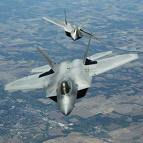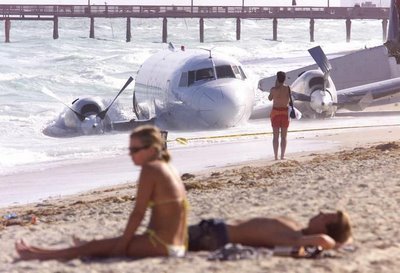|
previous topic :: next topic |
| Author |
Message |
Gman

Since 11 Feb 2006
4911 Posts
Portland
Unstrapped
|
 Mon Mar 17, 08 8:24 pm OT Scary Plane Rides Mon Mar 17, 08 8:24 pm OT Scary Plane Rides |
 |
|
Was flying through some weather on a commercial flight Denver to St. Louis today when lightining blasted the wing 20 ft from the window I was sitting - well i was in the middle seat - lady next to me wasn't too happy but no burn marks - sounded like the engine exploded - looked sorta like the scene in Star Wars were the Evil Emperor fries Luke with tendrils of lightining.
Question - is this no bigee or do chunks get blown out of planes from time to time - was thinking Lost but with no neato island just children of the corn
|
|
|
Kraemer

Since 24 Apr 2006
1736 Posts
Sky Pilot
Unicorn Captain
|
 Mon Mar 17, 08 8:31 pm Mon Mar 17, 08 8:31 pm |
 |
|
| Question - did chunks get blown out of your ass? Cause they would have come flying out mine.
|
|
|
Spike

Since 13 May 2007
1414 Posts
Alameda
Spelling Expert
|
 Mon Mar 17, 08 8:35 pm Mon Mar 17, 08 8:35 pm |
 |
|
| spent my freshman year at the university of north dakota aviation school. they have a weather plane they fly into thunderstorms all the time. They keep track of lightning strikes with lightning bolt stickers on the nose. they had quite a few. it is quite common, though it is more of a risk with composite planes (Boeing's new 787) as there is no aluminum skin to conduct the lightning. in a composite plane, the lightning burns through the skin and hits whatever metal is underneath. if that be electronics they will likely be fried unless special precautions are taken (which usually are)
|
|
|
Reaper356

Since 10 Dec 2006
781 Posts
Salem / LC Oregon
Opinionated
|
 Mon Mar 17, 08 9:32 pm Mon Mar 17, 08 9:32 pm |
 |
|
| Sounds like a question for Nak.
|
|
|
jdk
Since 21 Dec 2005
333 Posts
Obsessed
|
 Mon Mar 17, 08 11:30 pm Mon Mar 17, 08 11:30 pm |
 |
|
We got pummeled by hail in a baron going ~200 knots one time. we were miles from the cell (could see it on the storm scope) but the hail got blown out the top or something weird. i thought we were toast, it was a close call
i knew a guy who flew a lear into a cell back in the day. he said he wouldn't do it again
|
|
|
Spike

Since 13 May 2007
1414 Posts
Alameda
Spelling Expert
|
 Mon Mar 17, 08 11:38 pm Mon Mar 17, 08 11:38 pm |
 |
|
I did some stupid shit when I was still flying. Did some zero-G maneuvers over the coastal range in a Cessna. Not a good idea with a gravity feed fuel tanks. the engine nearly died 
|
|
|
Reaper356

Since 10 Dec 2006
781 Posts
Salem / LC Oregon
Opinionated
|
 Tue Mar 18, 08 7:25 am Tue Mar 18, 08 7:25 am |
 |
|
Sounds like you need an F-22! 
We're trying to get some in Salem right now!
2 engines - in case one dies! 
 |
| |
f22.jpg |
|
|
|
barfly

Since 31 Mar 2005
1216 Posts
Portland
BRACKISH
|
 Tue Mar 18, 08 8:08 am Tue Mar 18, 08 8:08 am |
 |
|
G- you're a weather magnet. Isn't that obvious by now? Now that you know your powers, learn to channel them and bring us wind   . .
|
|
|
Nak

Since 19 May 2005
4312 Posts
Camas
Site Lackey
CGKA Member
|
 Tue Mar 18, 08 9:33 am Tue Mar 18, 08 9:33 am |
 |
|
The effects of a lightning strike can vary. At worst, a hull loss is possible, although that is rare. (Hull loss = total loss of the aircraft.) Most lightning strikes are really static discharges. Static electricity builds up on an airframe and then discharges violently. It looks like a lightning strike, but the effects are not as severe... Modern aircraft are designed to minimize the effects of either occurrence, but it's still a bad thing.
USAF WC-130 "Hurricane Hunters" will fly into a hurricane using a spiral flight path, trying to avoid any penetration of a thunderstorm cell. Occasionally, they do enter one, but these are enormously powerful aircraft specially modified for this mission.
Lightning is only one of the risks involved with penetrating a CB (thunderstorm). Thunderstorms can and do kill airplanes. Airline pilots will do whatever it takes to deviate around a CB. A rule of thumb is 1 mile away for every knot of wind downwind of the storm. Lines of thunderstorms can be penetrated through breaks in the cells. You can "pick your way through" using radar. This can be very tricky in the Midwestern United States because CBs there tend to build much faster than in other parts of the world. This penetration may feel like a storm to the passengers, but in reality is nowhere near as bad.
Gman, It's hard to say what exactly happened on your flight, but my guess is that the pilots ventured too close to a CB. Some airlines seem to "push the envelope" a bit as far as getting close to CB cells. My attitude would be "WHAT THE HELL ARE THOSE DUMBFUCKS UP IN THE COCKPIT DOING?!?!?!" You were probably never at a huge risk, but if they were pushing it you should be pissed. Call the airline and demand to be kept apprised of the investigation findings. There will be an investigation. Hit me up if they aren't cooperative.
Sometimes shit just happens. However if this was the result of pilot error, demand a total refund of your ticket plus a free trip of your choosing. Tell the airline that will be a lot cheaper than the lawsuit.
|
|
|
pkh

Since 27 Feb 2005
6549 Posts
Couve / Hood
Honored Founder
|
 Tue Mar 18, 08 10:04 am Tue Mar 18, 08 10:04 am |
 |
|
| I thought big commercial jets were designed to take a lightning strike such as that it travels through the plane and continues down to the ground.
|
|
|
Nak

Since 19 May 2005
4312 Posts
Camas
Site Lackey
CGKA Member
|
 Tue Mar 18, 08 10:45 am Tue Mar 18, 08 10:45 am |
 |
|
| pkh wrote: | | I thought big commercial jets were designed to take a lightning strike such as that it travels through the plane and continues down to the ground. |
Most of the time, the lightning will do minimal damage because of design features. It's still something you want to avoid. Getting too close to a CB has other risks that are best avoided as well. Hail, extreme turbulence, windshear; all things that are best avoided. Flying directly into a thunderstorm can be survived most of the time...
Most of the time, what passengers perceive as thunderstorm penetration is really flying too close to a thunderstorm.
|
|
|
broadbandito

Since 26 Apr 2005
342 Posts
CSO headwaters
WheatHead
|
 Tue Mar 18, 08 10:55 am Tue Mar 18, 08 10:55 am |
 |
|
I've been in a plane twice when lightening appeared to strike. It didn't seem to be a big deal, though in both cases fellow passengers assumed the crash position immediately afterward (on their own accord, not based on crew instruction). I would guess it could "leave a scar" on paint outside the metal, but I don't think parts get "blown off" very often.
However, if you're flying on a mission for a cancer charity and you're also concerned about your online reputation, BlowMeAKiss probably has some statistics regarding safety.
|
|
|
Gman

Since 11 Feb 2006
4911 Posts
Portland
Unstrapped
|
 Tue Mar 18, 08 4:23 pm Tue Mar 18, 08 4:23 pm |
 |
|
| Thanks Nak - great post.
|
|
|
Spike

Since 13 May 2007
1414 Posts
Alameda
Spelling Expert
|
 Tue Mar 18, 08 5:20 pm Tue Mar 18, 08 5:20 pm |
 |
|
| Nak wrote: | | This penetration may feel like a storm to the passengers, but in reality is nowhere near as bad. |
you are still talking about airplanes right...  ? ?
Also, picking your way through storm using radar is very dangerous. In heavy storms the radar may not penetrate through the entire cell and will display seemingly clear airspace a few miles ahead of the storm, when in fact, the worst is yet to come. There have been aircraft that have crashed due to encountering baseball sized hail after making their way into this "peaceful" airspace.
Therefore, just because the radar doesn't show anything, doesn't mean its not there.
|
|
|
Nak

Since 19 May 2005
4312 Posts
Camas
Site Lackey
CGKA Member
|
 Tue Mar 18, 08 5:52 pm Tue Mar 18, 08 5:52 pm |
 |
|
| Spike wrote: | Also, picking your way through storm using radar is very dangerous. In heavy storms the radar may not penetrate through the entire cell and will display seemingly clear airspace a few miles ahead of the storm, when in fact, the worst is yet to come. There have been aircraft that have crashed due to encountering baseball sized hail after making their way into this "peaceful" airspace.
Therefore, just because the radar doesn't show anything, doesn't mean its not there. |
Absolutely true. The phenomenon you're referring to is called "Attenuation". Proper use of the radar is required to determine the area of attenuation. Any area of attenuation is assumed to be severe weather. Multiple resources should be used to determine the best course. (Current satellite imagery relayed from dispatch, ground based radar, etc.) Sometimes a line can be safely crossed, sometimes it can't. It takes extensive training, years of experience and expert judgement to make the call. Sounds corny, but it's true.
Static discharges happen, but rarely in US airlines. Lightning strikes are even rarer. Once it's happened, if you're still flying it's unlikely there's any serious damage. It's possible to have one with no pilot error; sometimes shit happens.
|
|
|
jdk
Since 21 Dec 2005
333 Posts
Obsessed
|
 Wed Mar 19, 08 11:42 am Wed Mar 19, 08 11:42 am |
 |
|
picking your way through with radar is sometimes the only choice with piston engines. with a turbine you can go high and get there fast, so its easier to avoid weather (go around or over). also in the midwest, where i got to ride along on many flights, its often vfr between the cells. you know exactly where the cell is and where it isn't. problem is that you are squeezed between two or more so you can only get so much buffer. i've been through some sketch situations in the mountains too. here again the piston makes it harder. you are in ice, you can't go higher because you are maxed out and/or collecting ice. you can't go lower because there are mountains down there somewhere 
|
|
|
Mark

Since 20 Jun 2005
3678 Posts
I need my fix because I'm a
Naishaholic
|
 Wed Mar 19, 08 2:38 pm Wed Mar 19, 08 2:38 pm |
 |
|
Could have been worse
 |
| |
On_The_Beach.jpg |
_________________
Cleverly disguised as an adult...
www.naishkites.com |
|
|
|




